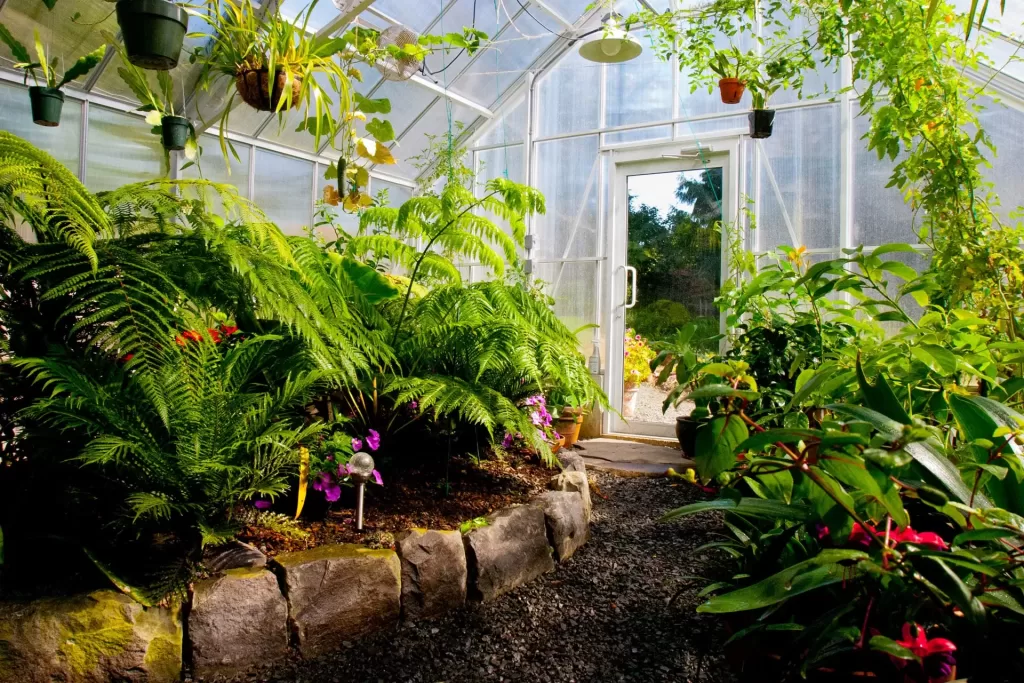
In a moderate climate, the best choice for keeping a greenhouse above freezing is a small electric heater. For larger greenhouses or small greenhouses in cold climates or those requiring a hot house environment, we would recommend electric, propane, or Natural gas heaters. The necessary BTU capacity (British thermal unit) is dictated by four things:
Our team of greenhouse experts has a handy formula that will calculate the necessary heat required based on the information you provide. Contact our team for more details.
Solar panels would provide the electricity required to produce some energy in a warmer climate. If you live in a cold climate, the solar field will have to be substantial to generate enough energy to heat a greenhouse. A backup source of power is recommended in the event of cold, cloudy days.
Alternatively, there are passive ways to capture heat that might appeal to many gardeners. Black barrels filled with water are commonly used to heat a greenhouse.
By implementing energy curtains, you can optimize your greenhouse’s energy efficiency by reducing the amount of space that needs to be heated. This smart solution allows you to retain heat generated during the day and focus on heating only the area in use.
For those who want to create different zones in their greenhouse, consider implementing energy curtains or plastic partitions to create temperature differences. However, we also offer the option to include a built-in partition wall as an added feature for your greenhouse.
For optimal plant growth, we recommend avoiding in-floor heating as the sole source of heat. This can lead to root burn. Instead, we suggest using radiant heat from baseboards, as it is more natural for plants compared to forced air.
The most natural and gentle way to cool your plants is with passive ventilation. Our greenhouses incorporate automatic ridge vents and optional side venting. Convection theory takes over as hot air rises out and cooler air is drawn through the lower openings.
For those with larger greenhouses or residing in hotter climates, it’s important to consider implementing a forced ventilation system to avoid overheating. A combination of exhaust fans and motorized intake shutters with a thermostat are usually necessary for this. Keep in mind that this system will be relied upon for most of spring, summer, and fall, but don’t forget about your passive ventilation methods too! This will help reduce extreme temperature fluctuations and will be better for your plants. Just be cautious of occasional warmer winter days that could potentially damage your plants with a sudden flash of cold air.
Diffusing harsh sunlight will also minimize heat build-up and harmful rays. Many plastic coverings act as a built-in shade system. With a glass greenhouse, some form of shading will be required if there is not adequate natural shade available in your yard. Many greenhouse owners still use whitewash to diffuse the sun or ask us about our various shade cloth options.
Air circulation is very important and in fact, it is more important than most people realize. Every greenhouse needs to have a circulating fan always moving air. Although the idea is basic, the principle is critical. Plants need fresh air for a healthy root system and a constant flow of air prevents pockets of warm or cool air from staying in corners. Airflow will also regulate temperatures and increase efficiency in the greenhouse. Lastly, air circulating in your greenhouse will prevent mold and algae from forming as condensation is less likely to settle.
Strategically place your heater on the floor, directing it inside of the greenhouse to eliminate heat loss. Enhance air circulation by positioning a circulating fan on bench level, pointing upwards and towards the door. This creates a much-needed circular motion, boosting the overall efficiency of your greenhouse. For larger greenhouses, our small but mighty Caframo circulating fans will be your new best friend.
Are you tired of being concerned about power outages interrupting your plants’ growth? Here’s a tip: invest in a backup generator or gas heating system. And for those unexpected emergencies, portable camping heaters are a quick and effective solution. Don’t let power outages hold you back from achieving the beautiful blooms you desire.